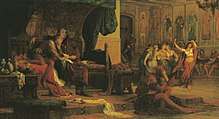Ulrich II, Count of Celje
Ulrich II, or Ulrich of Celje (Slovene: Ulrik Celjski also Urh Celjski, Hungarian: Cillei Ulrik, German: Ulrich II von Cilli; 16 February 1406 – 9 November 1456), was the last Princely Count of Celje. At the time of his death, he was captain general and de facto regent of Hungary, ban (governor) of Slavonia, and feudal lord of vast areas in present-day Slovenia, Croatia, Bosnia, Austria, and Slovakia. He was also a claimant to the Bosnian throne.[1] This accumulation of power prompted his assassination by the hands of the Hunyadi clan which plunged Hungary into civil unrest that was resolved a year later by the sudden death of king Ladislas the Posthumous and the election of Matthias Corvinus as king. All of Ulrich's possessions in the Holy Roman Empire were inherited by the Habsburg ruler Frederick III, while his possessions in Hungary were reverted to the crown.
Ulrich of Celje | |
|---|---|
Portrait (from ca. 1700) | |
| Coat of arms | |
| Holding(s) | County of Celje |
| Titles and styles
Count | |
| Born | 16 February 1406 Krško |
| Died | 9 November 1456 (aged 49–50) Belgrade |
| Noble family | Counts of Celje |
| Spouse(s) | Kantakuzina Katarina Branković |
| Issue
(see below) | |
| Father | Frederick II |
| Mother | Elizabeth of Frankopan |
| Religion | Roman Catholic |
Life
Ulrich II[2] was the son of Count Frederick II of Celje and his wife Elizabeth, a scion of the Croatian House of Frankopan and a grand daughter of Francesco I da Carrara, lord of Padua. Little is known of his youth. In about 1432 he married Kantakuzina Katarina Branković, daughter of Đurađ Branković, despot of Serbia.,[3] and the sister of Mara Branković.
His influence in the affairs of the Kingdom of Hungary and the Holy Roman Empire soon overshadowed that of his father, with whom he was raised to a Prince of the Empire by Emperor Sigismund of Luxembourg in 1436. This led to feuds with the Austrian House of Habsburg, wounded in their rights as Styrian overlords of Celje, ending, however, in an alliance with the Habsburg King Albert II of Germany, who made Ulrich his lieutenant in Bohemia for a short while. Upon King Albert's death in 1439, Ulrich took up the cause of his widow Elizabeth of Luxembourg, and presided at the coronation of her infant son Ladislaus the Posthumous with the Holy Crown of Hungary in 1440.[3]
A feud with the Hungarian Hunyadi family followed, embittered by John Hunyadi's failed attack on the forces of the Ottoman Empire at the Battle of Varna in 1444—while Ulrich remained idle—and Hunyadi's refusal to recognize Ulrich's claim to Bosnia on the death of King Tvrtko II (1443). In 1446 Hunyadi, now regent of Hungary, harried the Celje territories in Croatia-Slavonia; however his power was broken at the Second Battle of Kosovo in 1448, and Count Ulrich was able to lead a successful crusade, nominally in the Habsburg interest, into Hungary (1450).

In 1452, he forced Emperor Frederick III of Habsburg to hand over the boy king Ladislaus to his keeping, practically making him ruler of Hungary. In 1454 his power was increased by his succession to his father's vast wealth; and after the death of John Hunyadi at the Siege of Belgrade in 1456, he was named Captain General of Hungary by Ladislaus,[3] an office previously held by his rival.
Ulrich's triumph did not last: On 8 November, he entered the fortress of Belgrade with King Ladislaus; the next day he was killed by agents of John Hunyadi's son László in unknown circumstances. With him died the male line of the Counts of Celje.[4] He was buried in the Minorite Church of St. Mary in Celje. The eulogy was delivered by the famous humanist rhetorician and prelate Johann Roth.[5]
Ulrich's estates were claimed by his widow Catherine, his son-in-law Matthias Corvinus of Hungary - the younger brother of László Hunyadi - as well as Count John of Gorizia, and Emperor Frederick III of Habsburg, who outlived his rivals.
Ulrich's high ambitions were sharply criticized by Aeneas Sylvius (the later Pope Pius II), although his writings were politically minded, as he had served as the personal secretary of Emperor Frederick III at the height of his conflict with Ulrich.
On his mother's side, Ulrich was the closest surviving male descendant of Francesco I da Carrara, lord of Padua. However, he is not known to have ever pressed claim on the Carraresi inheritance.
Marriage and children
On 20 April 1434, Ulrich married Kantakuzina Katarina Branković. She was a daughter of Đurađ Branković and Eirene Kantakouzene. Through this marriage, Ulrich became the brother-in-law of the Ottoman sultan Murad II. Ulrich and Katarina had three children:[6]
- Herman IV of Celje (1439 – 1452).
- Georg of Celje (c. 1444 – 1445).
- Elizabeth of Celje (1441 – 1455), first wife of Matthias Corvinus of Hungary.
Ancestry
| Ancestors of Ulrich II, Count of Celje | ||||||||||||||||||||||||||||||||||||||||||||||||||||||||||||||||||||||||||||||||||||||||||||||||||||||||||||||||||||||||||||||||||||||||||||||||||||||||||||||||||||||||||||||||||||||||||||||||||||||||||||||||||||||||||||||||||||||||||||||||||||||||||||||||||||||||||||||||||||||||||||||||||||||||||||||||||||||||||||||||||||||||||||||||||||||||||||||||||||||||||||||||||||||||||||||||||||||||||||||||||||||||||||||||||||||||||||||||||||||||||||||||||||||||||||||||||||||||||||||||||||||||||||||||||||||||||||||||||||||||||||||||||||||||||||||||||||||||||||||||||||||||||||||||||||||||||||||||
|---|---|---|---|---|---|---|---|---|---|---|---|---|---|---|---|---|---|---|---|---|---|---|---|---|---|---|---|---|---|---|---|---|---|---|---|---|---|---|---|---|---|---|---|---|---|---|---|---|---|---|---|---|---|---|---|---|---|---|---|---|---|---|---|---|---|---|---|---|---|---|---|---|---|---|---|---|---|---|---|---|---|---|---|---|---|---|---|---|---|---|---|---|---|---|---|---|---|---|---|---|---|---|---|---|---|---|---|---|---|---|---|---|---|---|---|---|---|---|---|---|---|---|---|---|---|---|---|---|---|---|---|---|---|---|---|---|---|---|---|---|---|---|---|---|---|---|---|---|---|---|---|---|---|---|---|---|---|---|---|---|---|---|---|---|---|---|---|---|---|---|---|---|---|---|---|---|---|---|---|---|---|---|---|---|---|---|---|---|---|---|---|---|---|---|---|---|---|---|---|---|---|---|---|---|---|---|---|---|---|---|---|---|---|---|---|---|---|---|---|---|---|---|---|---|---|---|---|---|---|---|---|---|---|---|---|---|---|---|---|---|---|---|---|---|---|---|---|---|---|---|---|---|---|---|---|---|---|---|---|---|---|---|---|---|---|---|---|---|---|---|---|---|---|---|---|---|---|---|---|---|---|---|---|---|---|---|---|---|---|---|---|---|---|---|---|---|---|---|---|---|---|---|---|---|---|---|---|---|---|---|---|---|---|---|---|---|---|---|---|---|---|---|---|---|---|---|---|---|---|---|---|---|---|---|---|---|---|---|---|---|---|---|---|---|---|---|---|---|---|---|---|---|---|---|---|---|---|---|---|---|---|---|---|---|---|---|---|---|---|---|---|---|---|---|---|---|---|---|---|---|---|---|---|---|---|---|---|---|---|---|---|---|---|---|---|---|---|---|---|---|---|---|---|---|---|---|---|---|---|---|---|---|---|---|---|---|---|---|---|---|---|---|---|---|---|---|---|---|---|---|---|---|---|---|---|---|---|---|---|---|---|---|---|---|---|---|---|---|---|---|---|---|---|---|---|---|---|---|---|---|---|---|---|---|---|---|---|---|---|---|---|---|---|---|---|---|---|---|---|---|---|---|---|---|---|---|---|---|---|---|---|---|---|---|---|---|---|---|---|---|---|---|---|---|---|---|---|---|---|---|---|---|---|---|---|---|---|---|---|---|---|---|---|---|---|---|---|---|---|---|---|---|---|---|---|---|---|---|---|---|---|---|---|---|---|---|---|---|---|---|---|---|---|---|---|---|---|---|---|---|---|---|---|---|---|---|---|---|---|---|---|---|---|---|---|---|---|---|---|---|---|---|---|---|---|---|---|---|---|---|---|---|
| ||||||||||||||||||||||||||||||||||||||||||||||||||||||||||||||||||||||||||||||||||||||||||||||||||||||||||||||||||||||||||||||||||||||||||||||||||||||||||||||||||||||||||||||||||||||||||||||||||||||||||||||||||||||||||||||||||||||||||||||||||||||||||||||||||||||||||||||||||||||||||||||||||||||||||||||||||||||||||||||||||||||||||||||||||||||||||||||||||||||||||||||||||||||||||||||||||||||||||||||||||||||||||||||||||||||||||||||||||||||||||||||||||||||||||||||||||||||||||||||||||||||||||||||||||||||||||||||||||||||||||||||||||||||||||||||||||||||||||||||||||||||||||||||||||||||||||||||||
See also
References
| Wikimedia Commons has media related to Ulrich II of Celje. |
- Ćirković, Sima. Историја средњовековне босанске државе. Srpska književna zadruga: 1964, pp. 276.
- Enciklopedija Slovenije II, 1988, f. 14 COBISS 17411
-

- The Chronicles of Celje Archived 13 November 2007 at the Wayback Machine
- Jože Pogačnik, Starejše slovensko slovstvo (Maribor, 1980), pp. 472-76
- Cawley, Charles, Profile of Ulrich II, Medieval Lands database, Foundation for Medieval Genealogy,